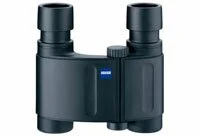The Binocular Site
Compact Binoculars
 People either love or hate compact binoculars. While many say avoid them, others love having them on hand, even if only as a back-up pair. Typically compact binoculars have a lens size of about 20mm to 25mm. Examples are 8x20 and 10x25. As always there are some pros to using them, however, there are certainly cons as well.
People either love or hate compact binoculars. While many say avoid them, others love having them on hand, even if only as a back-up pair. Typically compact binoculars have a lens size of about 20mm to 25mm. Examples are 8x20 and 10x25. As always there are some pros to using them, however, there are certainly cons as well.
Pros
- They are excellent for keeping as a second pair, stashed in a pocket or glove compartment, since they are so slim and lightweight.
- They are great for kids because their smaller size easily fits small faces and their light weight is perfect for little hands. Compact binoculars can have a smaller distance between the lenses that larger binoculars just can't achieve. This is great for little faces. Women may find them comfortable if they can't use other binoculars as well.
- They are often used in the opera or theater, to help viewers feel closer to the show even when they're in distant seats.
- They often allow close focus so they can be used to magnify objects that are closer.
- They can be put in your fishing vest and used to get a quick look when you aren't sure if that bump in the distance is a branch or trout in the water.
- They can be pulled out of your pocket quickly while hunting white tailed deer, and are often the preferred binoculars for doing so, particularly at 7x to 10x magnification.
- Some sets fold up easily so they are even more compact and out of the way, and they're so light it's easy to carry them 'round your neck while you're hiking. You might keep a more powerful pair in your knapsack for later, but these are easy to have right at hand at a moment's notice.
- They are often less expensive then standard sized binoculars, especially if made especially for kids.
Cons
- Compact binoculars are often lower quality both because parts must be smaller and because mechanisms are restricted to a tighter space.
- The smaller objective lenses (typically 20 to 25mm compared to your 35mm and up standard sets) naturally have a smaller field of view.
- The smaller objective lenses permit less light to enter the binoculars, making compacts fine for full daylight use, but completely ineffective in low light or dark environments.
- Exit pupils are reduced in compact binoculars. Again, minimal light is directed into your pupils. For example, if you have a set of compact 8x25's you determine the exit pupil by dividing 25 by 8. The result is an exit pupil of 3.1mm. Although the human pupils are dilated to about 2.5mm during the day, they expand to compensate for low light. In the evening one's pupils may dilate up to 7mm, so if the binoculars only send light through a diameter of less then half that, the image is just not optimal.
- Compact binoculars are harder to hold steady, and the smallest vibration can distort images.
- Smaller focusing devices can be hard to operate if you have large fingers.
- Compact binoculars may not include features such as image stabilization and other elements you could expect in standard sized models.
Models Available
- Zeiss has a pair of compact models known as Victory Compacts, available in 8x20 and 10x25. Either of these sets will work well for opera and theater use, or as back-up binoculars during hiking, mountain climbing, or nature observation. They weigh in at 8-9oz, and are only 4 and 5 inches long respectively. Their 2.5 mm exit pupils make them ideal for daylight use. Although some consider these to have superior optics, they are priced as high as standard sized binoculars.
- Nikon also offers a set of compacts, although theirs zoom as well. Their Eagleview binoculars are available in 8-24x25. The field of view is a narrow 80m, but they offer close focusing at 4m, and are only 119mm long, 110mm wide, and weigh in at only 350g! They have a slightly larger exit pupil of 3.1 mm, meaning they can be used in slightly dimmer environments than the Zeiss models.
- Bushnell offers several compact options as well, including their 8x21mm Powerviews, which fold up neatly as well as weighing in at 7oz. They are center focus, have roof prisms in BK-7, and are fully coated, although their exit pupil is 2.6 mm. Again, this is fine for full daylight use. They are only about $17.00 so while they may not be of the highest quality for professionals, they would be a good first set for a child's Christmas stocking or to go in your glove compartment.

